Child Safety in Early Learning: Diploma in Early Childhood Education
VerifiedAdded on 2023/04/21
|19
|4328
|388
Homework Assignment
AI Summary
This assignment delves into the critical aspects of child health and safety within the context of early childhood education and care. It highlights the significance of the National Quality Framework (NQF), National Quality Standards (NQS), and the Early Years Learning Framework (EYLF) in creating a secure and nurturing environment for children. The assignment addresses key standards and regulations, including hygiene practices, toy safety, and environmental safety, emphasizing the role of educators in promoting children's well-being. Furthermore, it explores practical strategies for calming hyperactive children, ensuring privacy during toileting, and maintaining personal hygiene. The document also discusses the importance of creating optimal sleep environments and communicating effectively with parents regarding children's health and safety needs. This resource is available on Desklib, a platform offering a wide range of study tools and solved assignments for students.
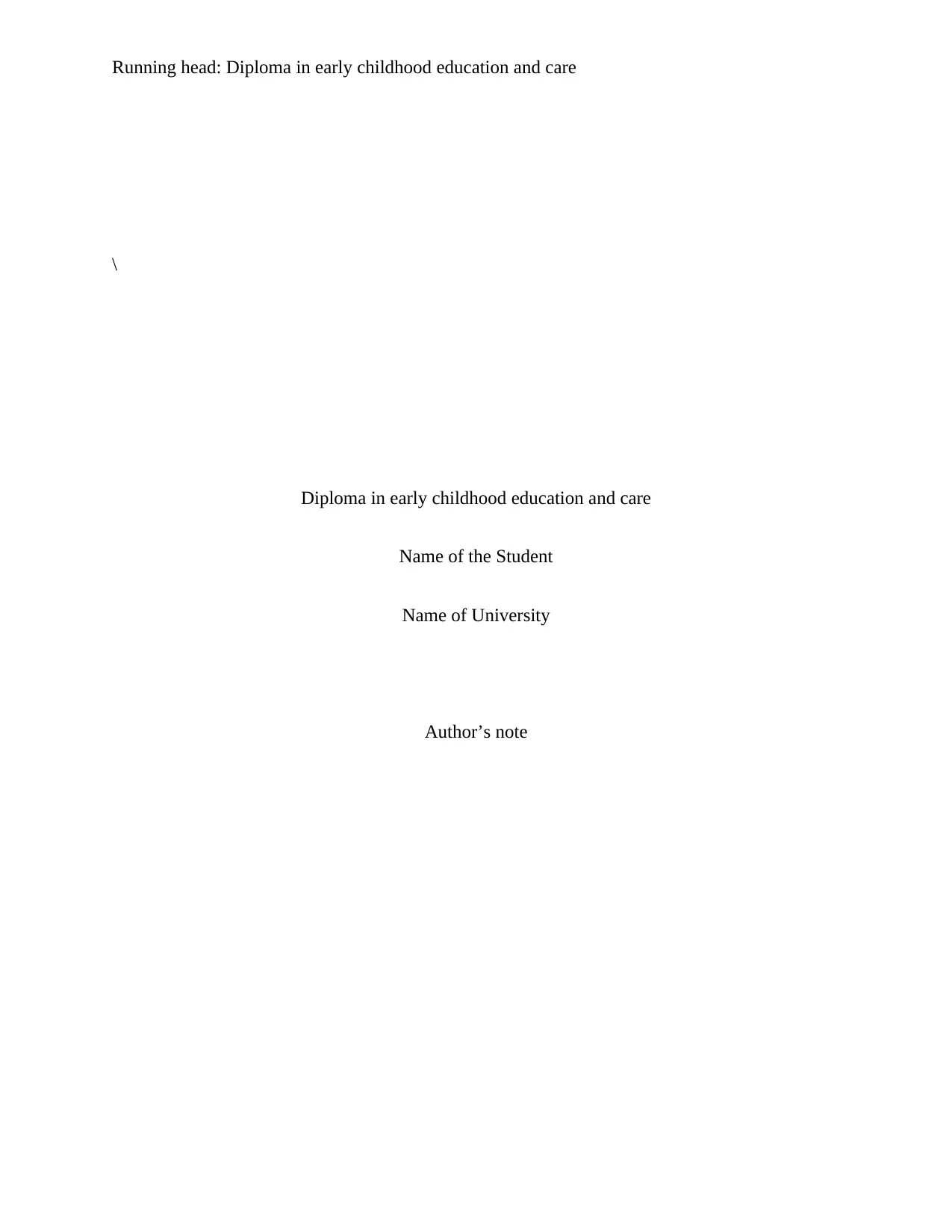
Running head: Diploma in early childhood education and care
\
Diploma in early childhood education and care
Name of the Student
Name of University
Author’s note
\
Diploma in early childhood education and care
Name of the Student
Name of University
Author’s note
Paraphrase This Document
Need a fresh take? Get an instant paraphrase of this document with our AI Paraphraser
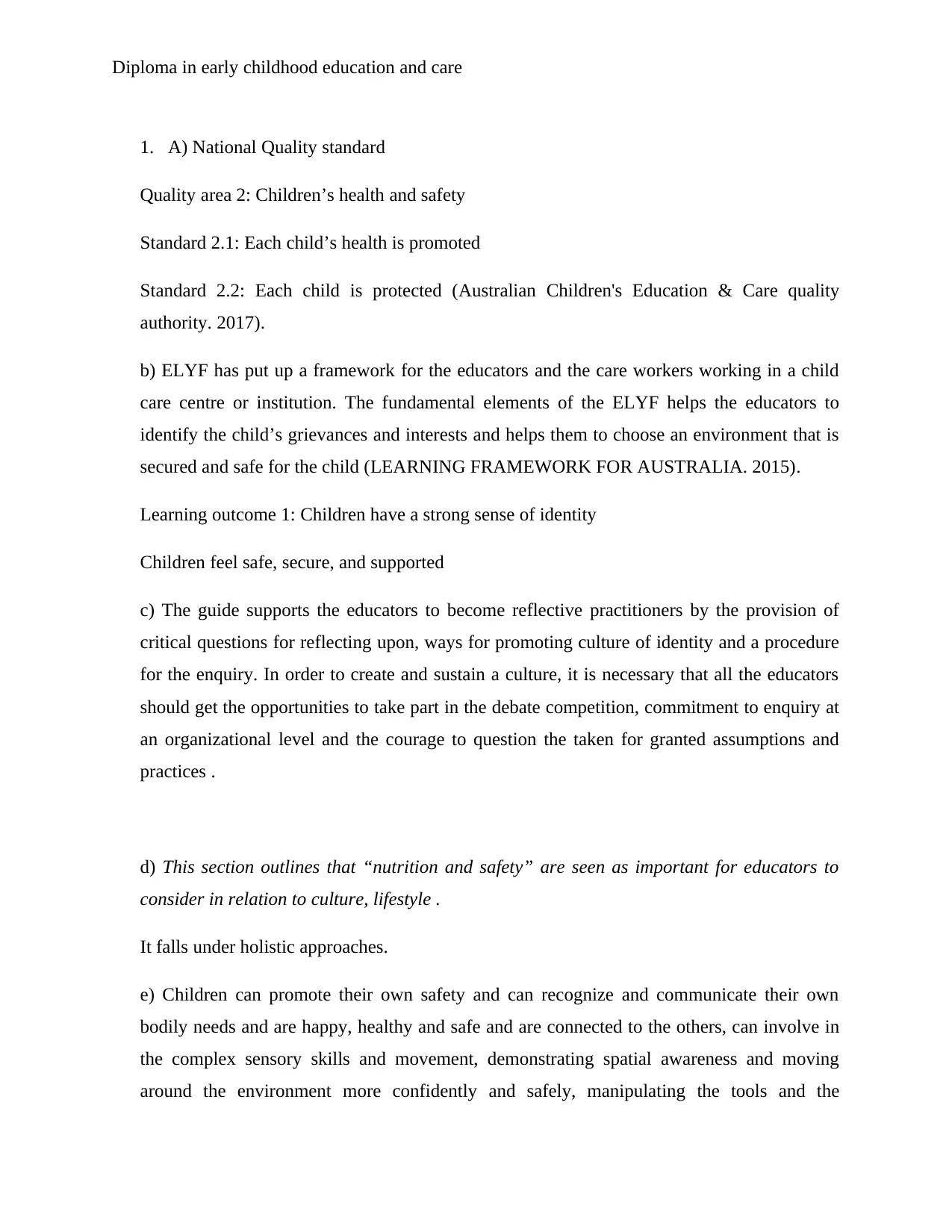
Diploma in early childhood education and care
1. A) National Quality standard
Quality area 2: Children’s health and safety
Standard 2.1: Each child’s health is promoted
Standard 2.2: Each child is protected (Australian Children's Education & Care quality
authority. 2017).
b) ELYF has put up a framework for the educators and the care workers working in a child
care centre or institution. The fundamental elements of the ELYF helps the educators to
identify the child’s grievances and interests and helps them to choose an environment that is
secured and safe for the child (LEARNING FRAMEWORK FOR AUSTRALIA. 2015).
Learning outcome 1: Children have a strong sense of identity
Children feel safe, secure, and supported
c) The guide supports the educators to become reflective practitioners by the provision of
critical questions for reflecting upon, ways for promoting culture of identity and a procedure
for the enquiry. In order to create and sustain a culture, it is necessary that all the educators
should get the opportunities to take part in the debate competition, commitment to enquiry at
an organizational level and the courage to question the taken for granted assumptions and
practices .
d) This section outlines that “nutrition and safety” are seen as important for educators to
consider in relation to culture, lifestyle .
It falls under holistic approaches.
e) Children can promote their own safety and can recognize and communicate their own
bodily needs and are happy, healthy and safe and are connected to the others, can involve in
the complex sensory skills and movement, demonstrating spatial awareness and moving
around the environment more confidently and safely, manipulating the tools and the
1. A) National Quality standard
Quality area 2: Children’s health and safety
Standard 2.1: Each child’s health is promoted
Standard 2.2: Each child is protected (Australian Children's Education & Care quality
authority. 2017).
b) ELYF has put up a framework for the educators and the care workers working in a child
care centre or institution. The fundamental elements of the ELYF helps the educators to
identify the child’s grievances and interests and helps them to choose an environment that is
secured and safe for the child (LEARNING FRAMEWORK FOR AUSTRALIA. 2015).
Learning outcome 1: Children have a strong sense of identity
Children feel safe, secure, and supported
c) The guide supports the educators to become reflective practitioners by the provision of
critical questions for reflecting upon, ways for promoting culture of identity and a procedure
for the enquiry. In order to create and sustain a culture, it is necessary that all the educators
should get the opportunities to take part in the debate competition, commitment to enquiry at
an organizational level and the courage to question the taken for granted assumptions and
practices .
d) This section outlines that “nutrition and safety” are seen as important for educators to
consider in relation to culture, lifestyle .
It falls under holistic approaches.
e) Children can promote their own safety and can recognize and communicate their own
bodily needs and are happy, healthy and safe and are connected to the others, can involve in
the complex sensory skills and movement, demonstrating spatial awareness and moving
around the environment more confidently and safely, manipulating the tools and the
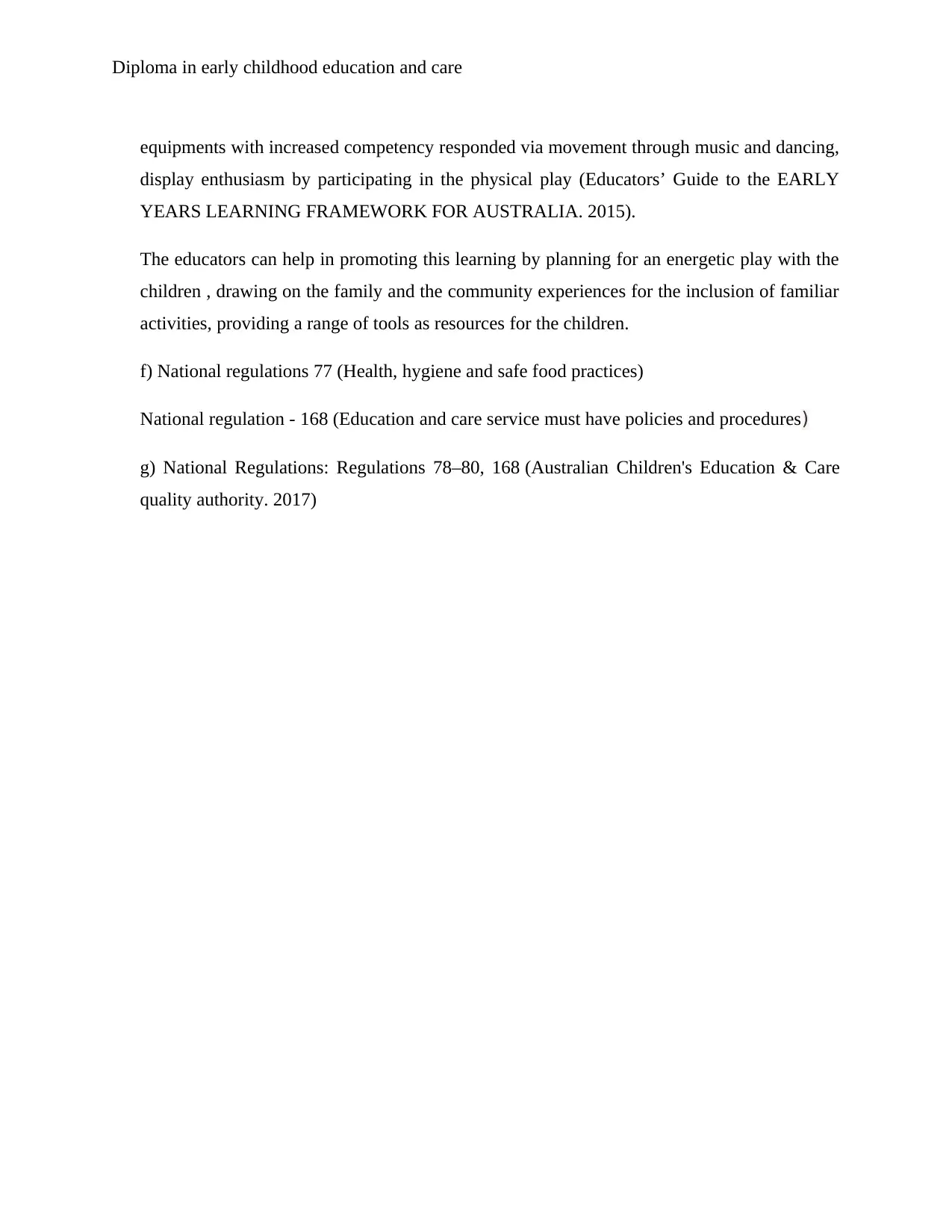
Diploma in early childhood education and care
equipments with increased competency responded via movement through music and dancing,
display enthusiasm by participating in the physical play (Educators’ Guide to the EARLY
YEARS LEARNING FRAMEWORK FOR AUSTRALIA. 2015).
The educators can help in promoting this learning by planning for an energetic play with the
children , drawing on the family and the community experiences for the inclusion of familiar
activities, providing a range of tools as resources for the children.
f) National regulations 77 (Health, hygiene and safe food practices)
National regulation - 168 (Education and care service must have policies and procedures)
g) National Regulations: Regulations 78–80, 168 (Australian Children's Education & Care
quality authority. 2017)
equipments with increased competency responded via movement through music and dancing,
display enthusiasm by participating in the physical play (Educators’ Guide to the EARLY
YEARS LEARNING FRAMEWORK FOR AUSTRALIA. 2015).
The educators can help in promoting this learning by planning for an energetic play with the
children , drawing on the family and the community experiences for the inclusion of familiar
activities, providing a range of tools as resources for the children.
f) National regulations 77 (Health, hygiene and safe food practices)
National regulation - 168 (Education and care service must have policies and procedures)
g) National Regulations: Regulations 78–80, 168 (Australian Children's Education & Care
quality authority. 2017)
⊘ This is a preview!⊘
Do you want full access?
Subscribe today to unlock all pages.

Trusted by 1+ million students worldwide
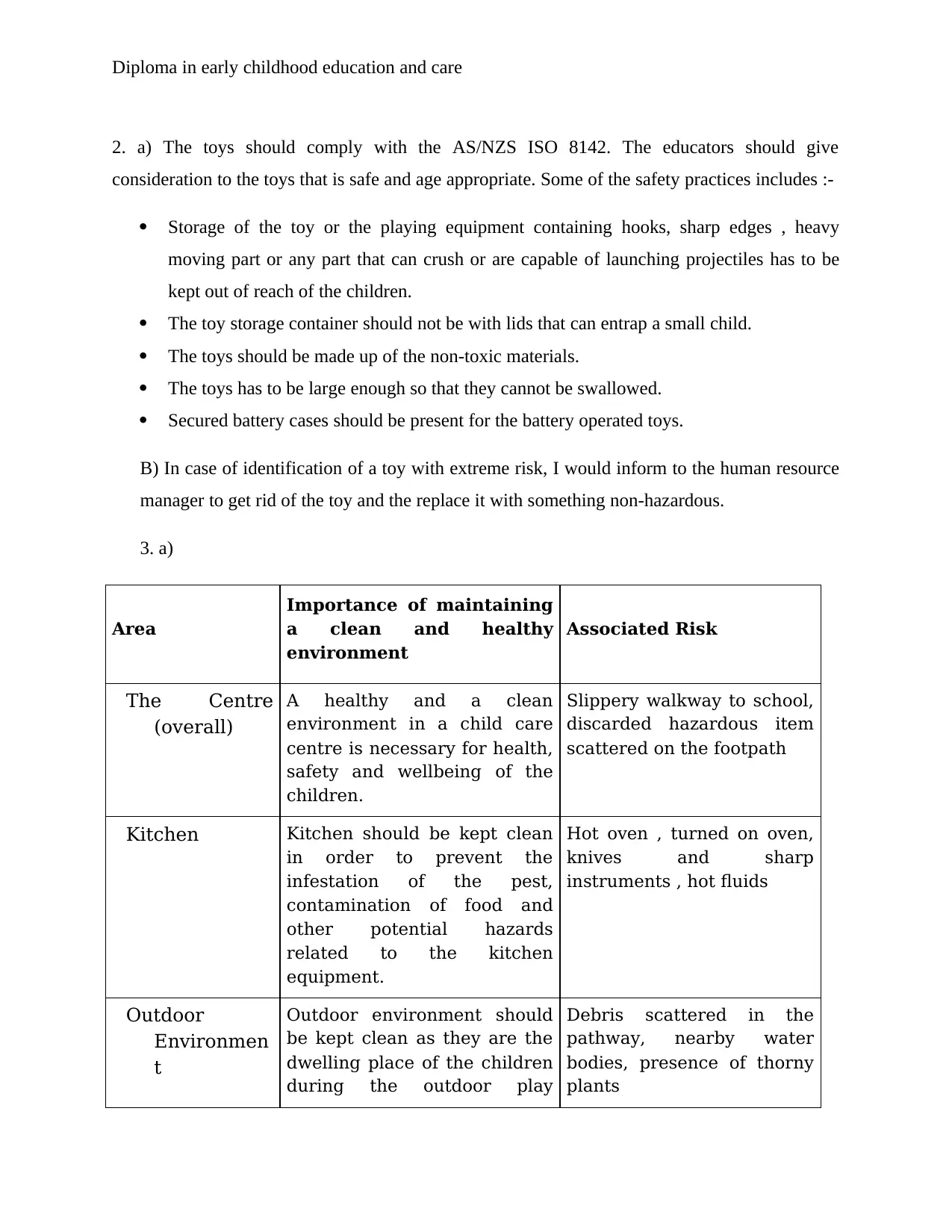
Diploma in early childhood education and care
2. a) The toys should comply with the AS/NZS ISO 8142. The educators should give
consideration to the toys that is safe and age appropriate. Some of the safety practices includes :-
Storage of the toy or the playing equipment containing hooks, sharp edges , heavy
moving part or any part that can crush or are capable of launching projectiles has to be
kept out of reach of the children.
The toy storage container should not be with lids that can entrap a small child.
The toys should be made up of the non-toxic materials.
The toys has to be large enough so that they cannot be swallowed.
Secured battery cases should be present for the battery operated toys.
B) In case of identification of a toy with extreme risk, I would inform to the human resource
manager to get rid of the toy and the replace it with something non-hazardous.
3. a)
Area
Importance of maintaining
a clean and healthy
environment
Associated Risk
The Centre
(overall)
A healthy and a clean
environment in a child care
centre is necessary for health,
safety and wellbeing of the
children.
Slippery walkway to school,
discarded hazardous item
scattered on the footpath
Kitchen Kitchen should be kept clean
in order to prevent the
infestation of the pest,
contamination of food and
other potential hazards
related to the kitchen
equipment.
Hot oven , turned on oven,
knives and sharp
instruments , hot fluids
Outdoor
Environmen
t
Outdoor environment should
be kept clean as they are the
dwelling place of the children
during the outdoor play
Debris scattered in the
pathway, nearby water
bodies, presence of thorny
plants
2. a) The toys should comply with the AS/NZS ISO 8142. The educators should give
consideration to the toys that is safe and age appropriate. Some of the safety practices includes :-
Storage of the toy or the playing equipment containing hooks, sharp edges , heavy
moving part or any part that can crush or are capable of launching projectiles has to be
kept out of reach of the children.
The toy storage container should not be with lids that can entrap a small child.
The toys should be made up of the non-toxic materials.
The toys has to be large enough so that they cannot be swallowed.
Secured battery cases should be present for the battery operated toys.
B) In case of identification of a toy with extreme risk, I would inform to the human resource
manager to get rid of the toy and the replace it with something non-hazardous.
3. a)
Area
Importance of maintaining
a clean and healthy
environment
Associated Risk
The Centre
(overall)
A healthy and a clean
environment in a child care
centre is necessary for health,
safety and wellbeing of the
children.
Slippery walkway to school,
discarded hazardous item
scattered on the footpath
Kitchen Kitchen should be kept clean
in order to prevent the
infestation of the pest,
contamination of food and
other potential hazards
related to the kitchen
equipment.
Hot oven , turned on oven,
knives and sharp
instruments , hot fluids
Outdoor
Environmen
t
Outdoor environment should
be kept clean as they are the
dwelling place of the children
during the outdoor play
Debris scattered in the
pathway, nearby water
bodies, presence of thorny
plants
Paraphrase This Document
Need a fresh take? Get an instant paraphrase of this document with our AI Paraphraser
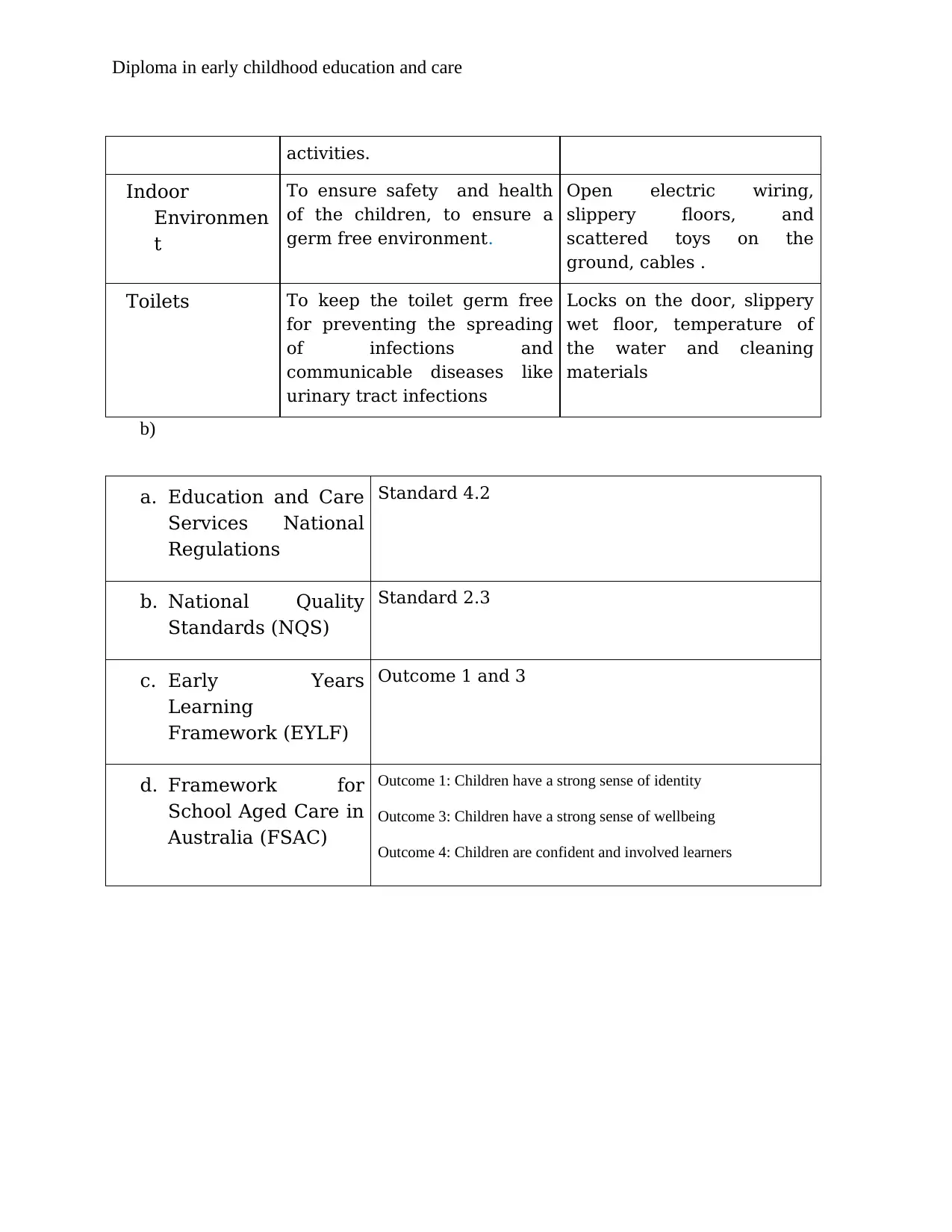
Diploma in early childhood education and care
activities.
Indoor
Environmen
t
To ensure safety and health
of the children, to ensure a
germ free environment.
Open electric wiring,
slippery floors, and
scattered toys on the
ground, cables .
Toilets To keep the toilet germ free
for preventing the spreading
of infections and
communicable diseases like
urinary tract infections
Locks on the door, slippery
wet floor, temperature of
the water and cleaning
materials
b)
a. Education and Care
Services National
Regulations
Standard 4.2
b. National Quality
Standards (NQS)
Standard 2.3
c. Early Years
Learning
Framework (EYLF)
Outcome 1 and 3
d. Framework for
School Aged Care in
Australia (FSAC)
Outcome 1: Children have a strong sense of identity
Outcome 3: Children have a strong sense of wellbeing
Outcome 4: Children are confident and involved learners
activities.
Indoor
Environmen
t
To ensure safety and health
of the children, to ensure a
germ free environment.
Open electric wiring,
slippery floors, and
scattered toys on the
ground, cables .
Toilets To keep the toilet germ free
for preventing the spreading
of infections and
communicable diseases like
urinary tract infections
Locks on the door, slippery
wet floor, temperature of
the water and cleaning
materials
b)
a. Education and Care
Services National
Regulations
Standard 4.2
b. National Quality
Standards (NQS)
Standard 2.3
c. Early Years
Learning
Framework (EYLF)
Outcome 1 and 3
d. Framework for
School Aged Care in
Australia (FSAC)
Outcome 1: Children have a strong sense of identity
Outcome 3: Children have a strong sense of wellbeing
Outcome 4: Children are confident and involved learners
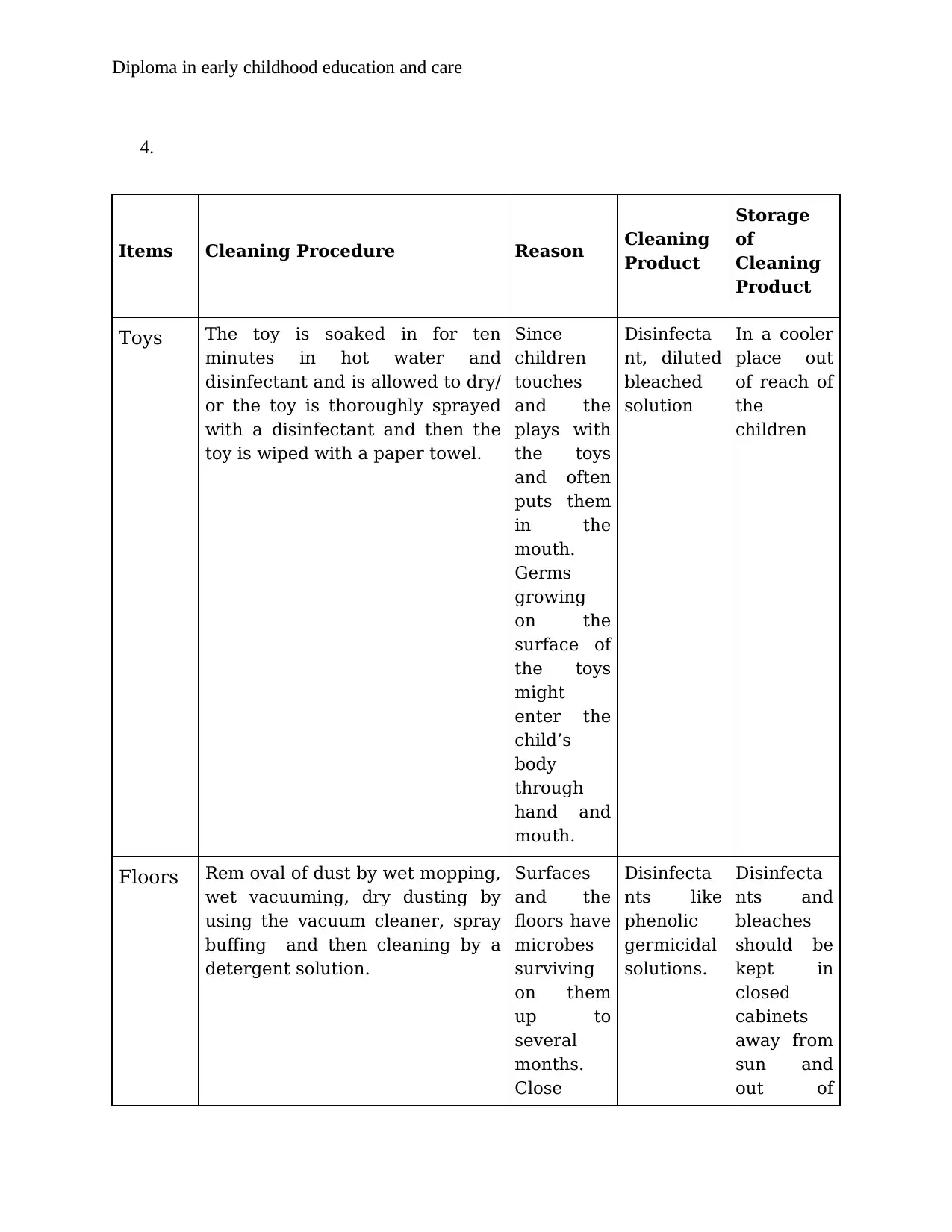
Diploma in early childhood education and care
4.
Items Cleaning Procedure Reason Cleaning
Product
Storage
of
Cleaning
Product
Toys The toy is soaked in for ten
minutes in hot water and
disinfectant and is allowed to dry/
or the toy is thoroughly sprayed
with a disinfectant and then the
toy is wiped with a paper towel.
Since
children
touches
and the
plays with
the toys
and often
puts them
in the
mouth.
Germs
growing
on the
surface of
the toys
might
enter the
child’s
body
through
hand and
mouth.
Disinfecta
nt, diluted
bleached
solution
In a cooler
place out
of reach of
the
children
Floors Rem oval of dust by wet mopping,
wet vacuuming, dry dusting by
using the vacuum cleaner, spray
buffing and then cleaning by a
detergent solution.
Surfaces
and the
floors have
microbes
surviving
on them
up to
several
months.
Close
Disinfecta
nts like
phenolic
germicidal
solutions.
Disinfecta
nts and
bleaches
should be
kept in
closed
cabinets
away from
sun and
out of
4.
Items Cleaning Procedure Reason Cleaning
Product
Storage
of
Cleaning
Product
Toys The toy is soaked in for ten
minutes in hot water and
disinfectant and is allowed to dry/
or the toy is thoroughly sprayed
with a disinfectant and then the
toy is wiped with a paper towel.
Since
children
touches
and the
plays with
the toys
and often
puts them
in the
mouth.
Germs
growing
on the
surface of
the toys
might
enter the
child’s
body
through
hand and
mouth.
Disinfecta
nt, diluted
bleached
solution
In a cooler
place out
of reach of
the
children
Floors Rem oval of dust by wet mopping,
wet vacuuming, dry dusting by
using the vacuum cleaner, spray
buffing and then cleaning by a
detergent solution.
Surfaces
and the
floors have
microbes
surviving
on them
up to
several
months.
Close
Disinfecta
nts like
phenolic
germicidal
solutions.
Disinfecta
nts and
bleaches
should be
kept in
closed
cabinets
away from
sun and
out of
⊘ This is a preview!⊘
Do you want full access?
Subscribe today to unlock all pages.

Trusted by 1+ million students worldwide
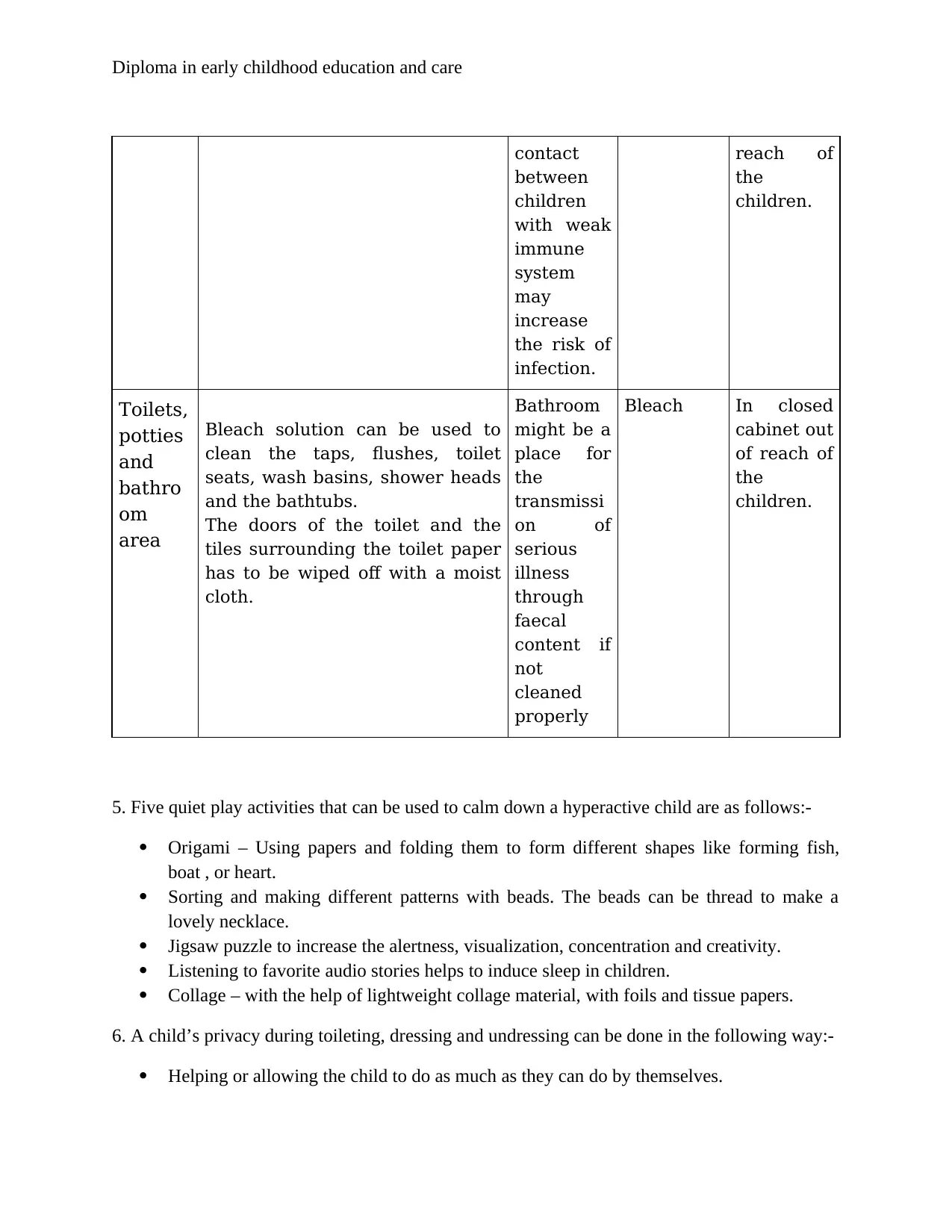
Diploma in early childhood education and care
contact
between
children
with weak
immune
system
may
increase
the risk of
infection.
reach of
the
children.
Toilets,
potties
and
bathro
om
area
Bleach solution can be used to
clean the taps, flushes, toilet
seats, wash basins, shower heads
and the bathtubs.
The doors of the toilet and the
tiles surrounding the toilet paper
has to be wiped off with a moist
cloth.
Bathroom
might be a
place for
the
transmissi
on of
serious
illness
through
faecal
content if
not
cleaned
properly
Bleach In closed
cabinet out
of reach of
the
children.
5. Five quiet play activities that can be used to calm down a hyperactive child are as follows:-
Origami – Using papers and folding them to form different shapes like forming fish,
boat , or heart.
Sorting and making different patterns with beads. The beads can be thread to make a
lovely necklace.
Jigsaw puzzle to increase the alertness, visualization, concentration and creativity.
Listening to favorite audio stories helps to induce sleep in children.
Collage – with the help of lightweight collage material, with foils and tissue papers.
6. A child’s privacy during toileting, dressing and undressing can be done in the following way:-
Helping or allowing the child to do as much as they can do by themselves.
contact
between
children
with weak
immune
system
may
increase
the risk of
infection.
reach of
the
children.
Toilets,
potties
and
bathro
om
area
Bleach solution can be used to
clean the taps, flushes, toilet
seats, wash basins, shower heads
and the bathtubs.
The doors of the toilet and the
tiles surrounding the toilet paper
has to be wiped off with a moist
cloth.
Bathroom
might be a
place for
the
transmissi
on of
serious
illness
through
faecal
content if
not
cleaned
properly
Bleach In closed
cabinet out
of reach of
the
children.
5. Five quiet play activities that can be used to calm down a hyperactive child are as follows:-
Origami – Using papers and folding them to form different shapes like forming fish,
boat , or heart.
Sorting and making different patterns with beads. The beads can be thread to make a
lovely necklace.
Jigsaw puzzle to increase the alertness, visualization, concentration and creativity.
Listening to favorite audio stories helps to induce sleep in children.
Collage – with the help of lightweight collage material, with foils and tissue papers.
6. A child’s privacy during toileting, dressing and undressing can be done in the following way:-
Helping or allowing the child to do as much as they can do by themselves.
Paraphrase This Document
Need a fresh take? Get an instant paraphrase of this document with our AI Paraphraser
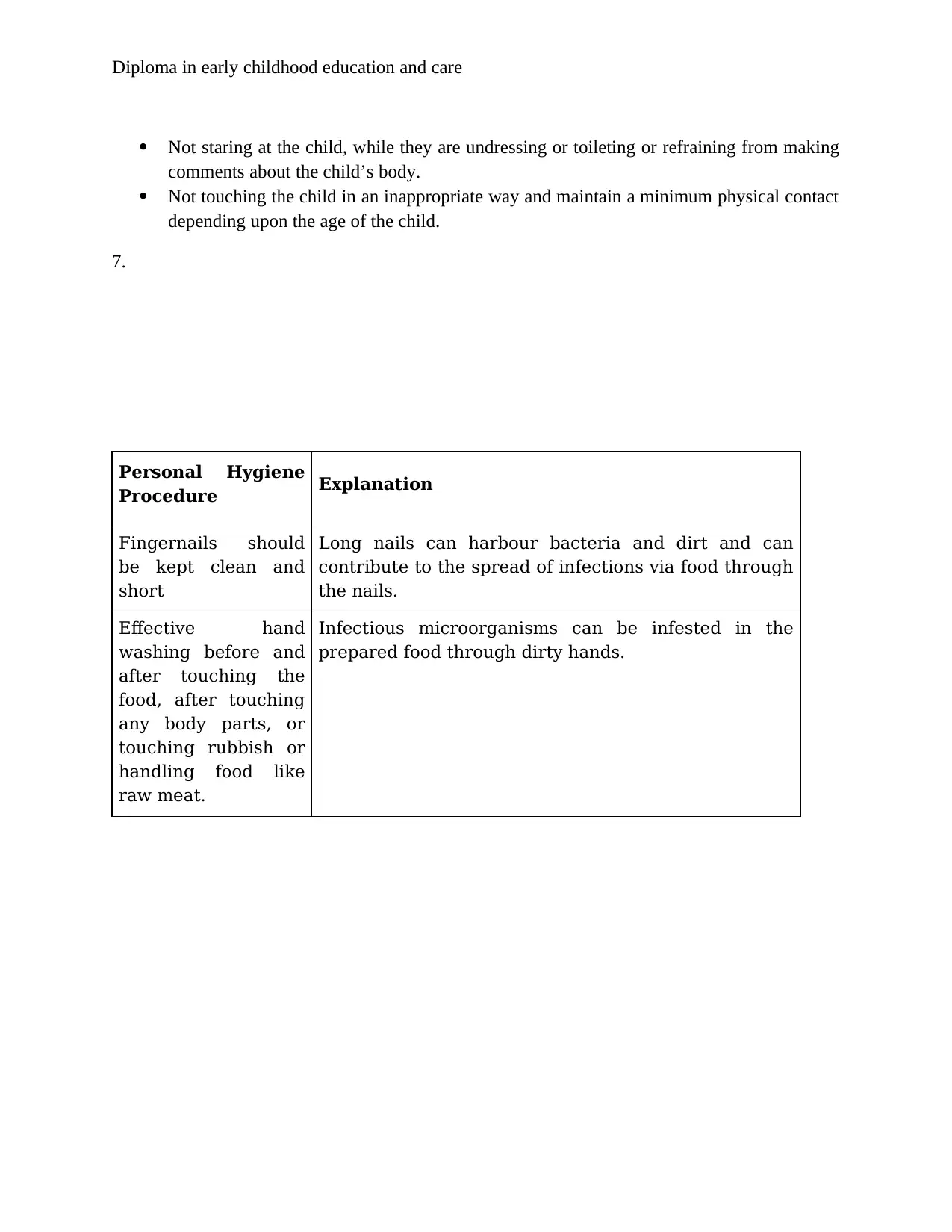
Diploma in early childhood education and care
Not staring at the child, while they are undressing or toileting or refraining from making
comments about the child’s body.
Not touching the child in an inappropriate way and maintain a minimum physical contact
depending upon the age of the child.
7.
Personal Hygiene
Procedure Explanation
Fingernails should
be kept clean and
short
Long nails can harbour bacteria and dirt and can
contribute to the spread of infections via food through
the nails.
Effective hand
washing before and
after touching the
food, after touching
any body parts, or
touching rubbish or
handling food like
raw meat.
Infectious microorganisms can be infested in the
prepared food through dirty hands.
Not staring at the child, while they are undressing or toileting or refraining from making
comments about the child’s body.
Not touching the child in an inappropriate way and maintain a minimum physical contact
depending upon the age of the child.
7.
Personal Hygiene
Procedure Explanation
Fingernails should
be kept clean and
short
Long nails can harbour bacteria and dirt and can
contribute to the spread of infections via food through
the nails.
Effective hand
washing before and
after touching the
food, after touching
any body parts, or
touching rubbish or
handling food like
raw meat.
Infectious microorganisms can be infested in the
prepared food through dirty hands.
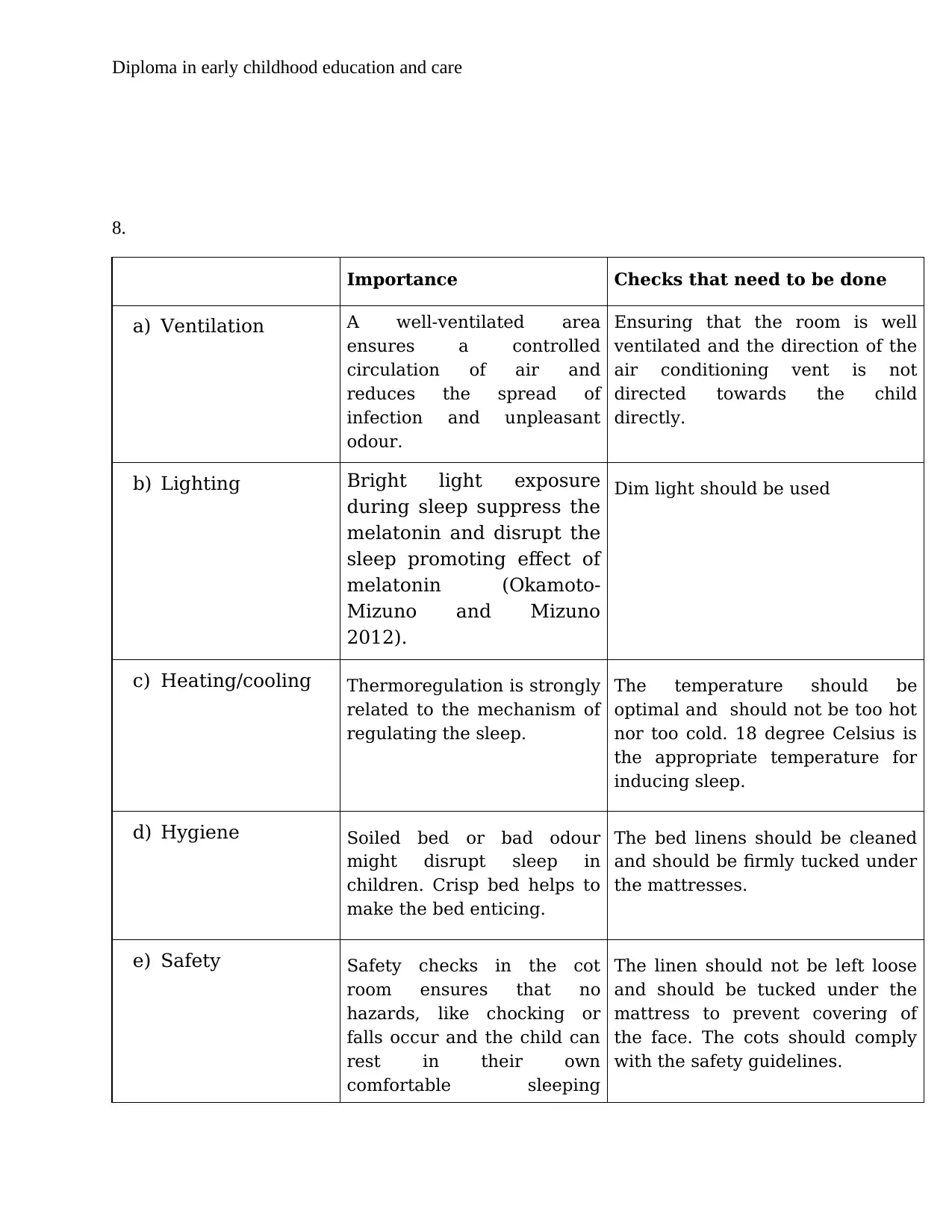
Diploma in early childhood education and care
8.
Importance Checks that need to be done
a) Ventilation A well-ventilated area
ensures a controlled
circulation of air and
reduces the spread of
infection and unpleasant
odour.
Ensuring that the room is well
ventilated and the direction of the
air conditioning vent is not
directed towards the child
directly.
b) Lighting Bright light exposure
during sleep suppress the
melatonin and disrupt the
sleep promoting effect of
melatonin (Okamoto-
Mizuno and Mizuno
2012).
Dim light should be used
c) Heating/cooling Thermoregulation is strongly
related to the mechanism of
regulating the sleep.
The temperature should be
optimal and should not be too hot
nor too cold. 18 degree Celsius is
the appropriate temperature for
inducing sleep.
d) Hygiene Soiled bed or bad odour
might disrupt sleep in
children. Crisp bed helps to
make the bed enticing.
The bed linens should be cleaned
and should be firmly tucked under
the mattresses.
e) Safety Safety checks in the cot
room ensures that no
hazards, like chocking or
falls occur and the child can
rest in their own
comfortable sleeping
The linen should not be left loose
and should be tucked under the
mattress to prevent covering of
the face. The cots should comply
with the safety guidelines.
8.
Importance Checks that need to be done
a) Ventilation A well-ventilated area
ensures a controlled
circulation of air and
reduces the spread of
infection and unpleasant
odour.
Ensuring that the room is well
ventilated and the direction of the
air conditioning vent is not
directed towards the child
directly.
b) Lighting Bright light exposure
during sleep suppress the
melatonin and disrupt the
sleep promoting effect of
melatonin (Okamoto-
Mizuno and Mizuno
2012).
Dim light should be used
c) Heating/cooling Thermoregulation is strongly
related to the mechanism of
regulating the sleep.
The temperature should be
optimal and should not be too hot
nor too cold. 18 degree Celsius is
the appropriate temperature for
inducing sleep.
d) Hygiene Soiled bed or bad odour
might disrupt sleep in
children. Crisp bed helps to
make the bed enticing.
The bed linens should be cleaned
and should be firmly tucked under
the mattresses.
e) Safety Safety checks in the cot
room ensures that no
hazards, like chocking or
falls occur and the child can
rest in their own
comfortable sleeping
The linen should not be left loose
and should be tucked under the
mattress to prevent covering of
the face. The cots should comply
with the safety guidelines.
⊘ This is a preview!⊘
Do you want full access?
Subscribe today to unlock all pages.

Trusted by 1+ million students worldwide
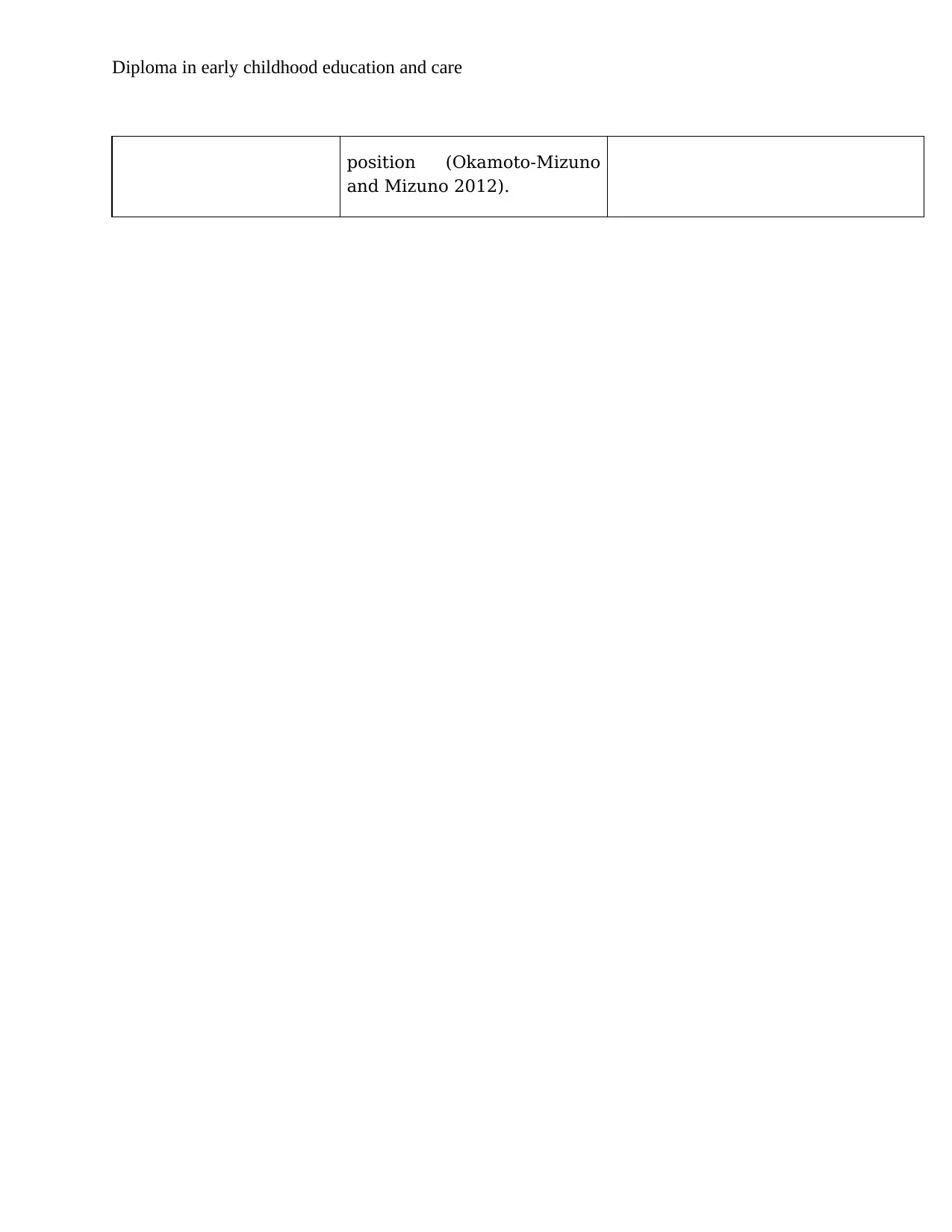
Diploma in early childhood education and care
position (Okamoto-Mizuno
and Mizuno 2012).
position (Okamoto-Mizuno
and Mizuno 2012).
Paraphrase This Document
Need a fresh take? Get an instant paraphrase of this document with our AI Paraphraser
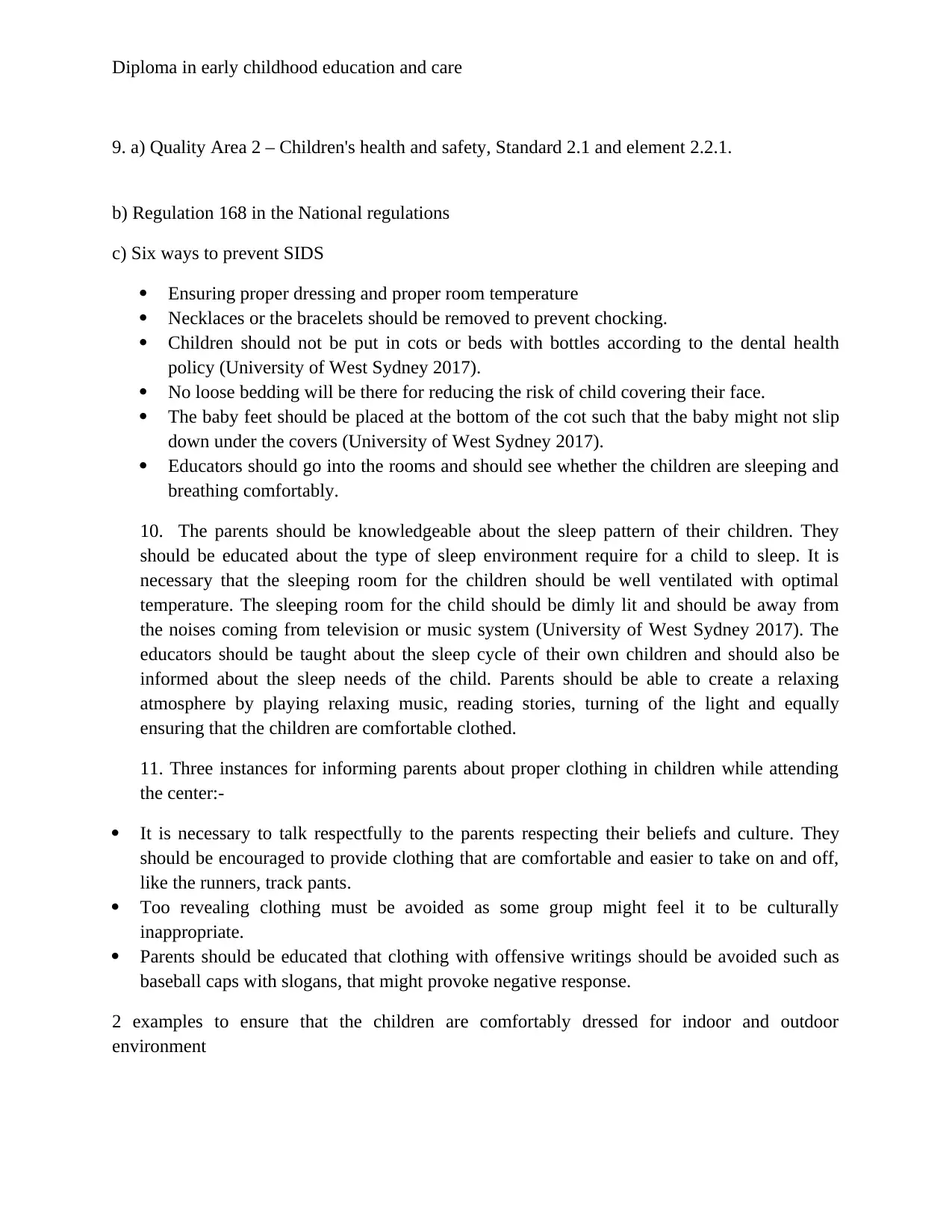
Diploma in early childhood education and care
9. a) Quality Area 2 – Children's health and safety, Standard 2.1 and element 2.2.1.
b) Regulation 168 in the National regulations
c) Six ways to prevent SIDS
Ensuring proper dressing and proper room temperature
Necklaces or the bracelets should be removed to prevent chocking.
Children should not be put in cots or beds with bottles according to the dental health
policy (University of West Sydney 2017).
No loose bedding will be there for reducing the risk of child covering their face.
The baby feet should be placed at the bottom of the cot such that the baby might not slip
down under the covers (University of West Sydney 2017).
Educators should go into the rooms and should see whether the children are sleeping and
breathing comfortably.
10. The parents should be knowledgeable about the sleep pattern of their children. They
should be educated about the type of sleep environment require for a child to sleep. It is
necessary that the sleeping room for the children should be well ventilated with optimal
temperature. The sleeping room for the child should be dimly lit and should be away from
the noises coming from television or music system (University of West Sydney 2017). The
educators should be taught about the sleep cycle of their own children and should also be
informed about the sleep needs of the child. Parents should be able to create a relaxing
atmosphere by playing relaxing music, reading stories, turning of the light and equally
ensuring that the children are comfortable clothed.
11. Three instances for informing parents about proper clothing in children while attending
the center:-
It is necessary to talk respectfully to the parents respecting their beliefs and culture. They
should be encouraged to provide clothing that are comfortable and easier to take on and off,
like the runners, track pants.
Too revealing clothing must be avoided as some group might feel it to be culturally
inappropriate.
Parents should be educated that clothing with offensive writings should be avoided such as
baseball caps with slogans, that might provoke negative response.
2 examples to ensure that the children are comfortably dressed for indoor and outdoor
environment
9. a) Quality Area 2 – Children's health and safety, Standard 2.1 and element 2.2.1.
b) Regulation 168 in the National regulations
c) Six ways to prevent SIDS
Ensuring proper dressing and proper room temperature
Necklaces or the bracelets should be removed to prevent chocking.
Children should not be put in cots or beds with bottles according to the dental health
policy (University of West Sydney 2017).
No loose bedding will be there for reducing the risk of child covering their face.
The baby feet should be placed at the bottom of the cot such that the baby might not slip
down under the covers (University of West Sydney 2017).
Educators should go into the rooms and should see whether the children are sleeping and
breathing comfortably.
10. The parents should be knowledgeable about the sleep pattern of their children. They
should be educated about the type of sleep environment require for a child to sleep. It is
necessary that the sleeping room for the children should be well ventilated with optimal
temperature. The sleeping room for the child should be dimly lit and should be away from
the noises coming from television or music system (University of West Sydney 2017). The
educators should be taught about the sleep cycle of their own children and should also be
informed about the sleep needs of the child. Parents should be able to create a relaxing
atmosphere by playing relaxing music, reading stories, turning of the light and equally
ensuring that the children are comfortable clothed.
11. Three instances for informing parents about proper clothing in children while attending
the center:-
It is necessary to talk respectfully to the parents respecting their beliefs and culture. They
should be encouraged to provide clothing that are comfortable and easier to take on and off,
like the runners, track pants.
Too revealing clothing must be avoided as some group might feel it to be culturally
inappropriate.
Parents should be educated that clothing with offensive writings should be avoided such as
baseball caps with slogans, that might provoke negative response.
2 examples to ensure that the children are comfortably dressed for indoor and outdoor
environment
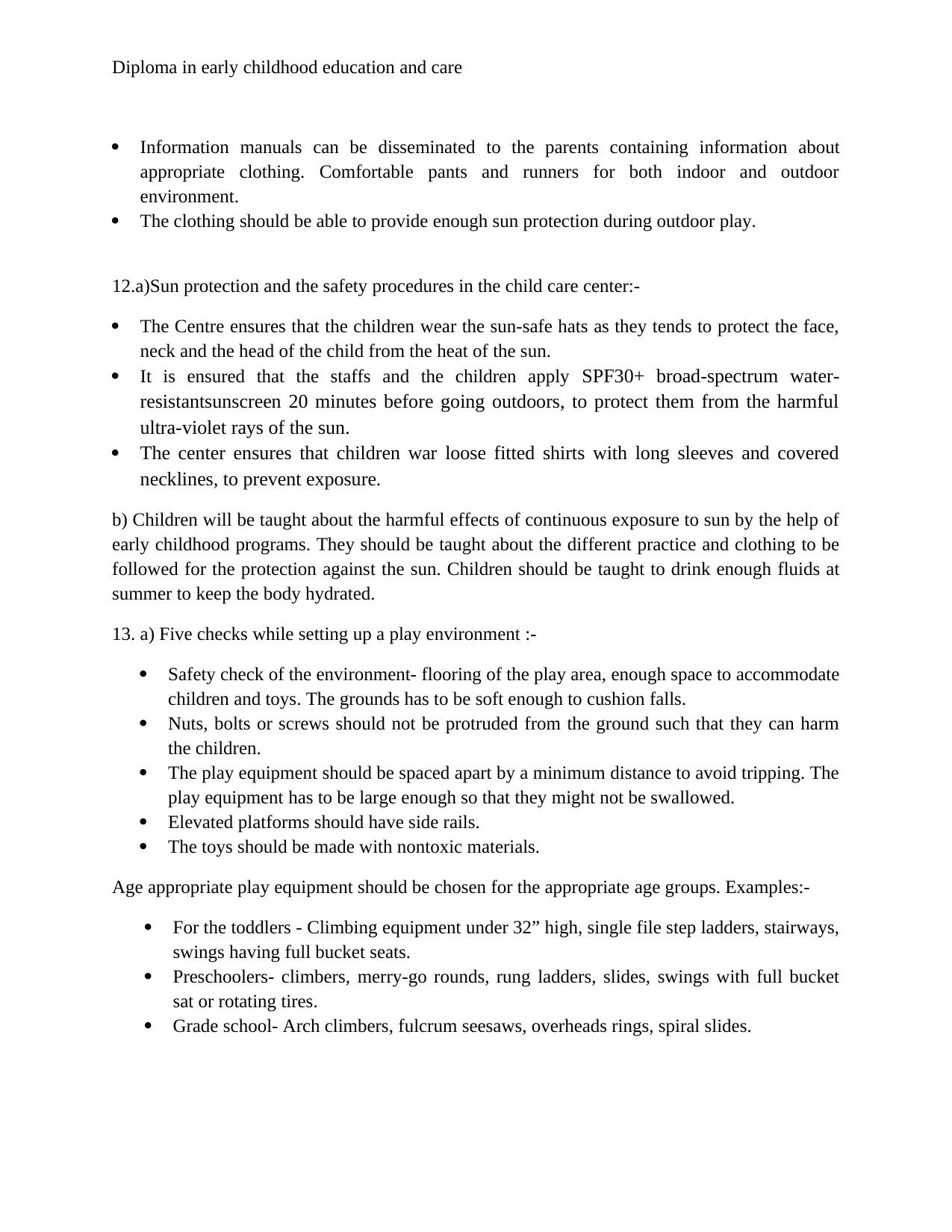
Diploma in early childhood education and care
Information manuals can be disseminated to the parents containing information about
appropriate clothing. Comfortable pants and runners for both indoor and outdoor
environment.
The clothing should be able to provide enough sun protection during outdoor play.
12.a)Sun protection and the safety procedures in the child care center:-
The Centre ensures that the children wear the sun-safe hats as they tends to protect the face,
neck and the head of the child from the heat of the sun.
It is ensured that the staffs and the children apply SPF30+ broad-spectrum water-
resistantsunscreen 20 minutes before going outdoors, to protect them from the harmful
ultra-violet rays of the sun.
The center ensures that children war loose fitted shirts with long sleeves and covered
necklines, to prevent exposure.
b) Children will be taught about the harmful effects of continuous exposure to sun by the help of
early childhood programs. They should be taught about the different practice and clothing to be
followed for the protection against the sun. Children should be taught to drink enough fluids at
summer to keep the body hydrated.
13. a) Five checks while setting up a play environment :-
Safety check of the environment- flooring of the play area, enough space to accommodate
children and toys. The grounds has to be soft enough to cushion falls.
Nuts, bolts or screws should not be protruded from the ground such that they can harm
the children.
The play equipment should be spaced apart by a minimum distance to avoid tripping. The
play equipment has to be large enough so that they might not be swallowed.
Elevated platforms should have side rails.
The toys should be made with nontoxic materials.
Age appropriate play equipment should be chosen for the appropriate age groups. Examples:-
For the toddlers - Climbing equipment under 32” high, single file step ladders, stairways,
swings having full bucket seats.
Preschoolers- climbers, merry-go rounds, rung ladders, slides, swings with full bucket
sat or rotating tires.
Grade school- Arch climbers, fulcrum seesaws, overheads rings, spiral slides.
Information manuals can be disseminated to the parents containing information about
appropriate clothing. Comfortable pants and runners for both indoor and outdoor
environment.
The clothing should be able to provide enough sun protection during outdoor play.
12.a)Sun protection and the safety procedures in the child care center:-
The Centre ensures that the children wear the sun-safe hats as they tends to protect the face,
neck and the head of the child from the heat of the sun.
It is ensured that the staffs and the children apply SPF30+ broad-spectrum water-
resistantsunscreen 20 minutes before going outdoors, to protect them from the harmful
ultra-violet rays of the sun.
The center ensures that children war loose fitted shirts with long sleeves and covered
necklines, to prevent exposure.
b) Children will be taught about the harmful effects of continuous exposure to sun by the help of
early childhood programs. They should be taught about the different practice and clothing to be
followed for the protection against the sun. Children should be taught to drink enough fluids at
summer to keep the body hydrated.
13. a) Five checks while setting up a play environment :-
Safety check of the environment- flooring of the play area, enough space to accommodate
children and toys. The grounds has to be soft enough to cushion falls.
Nuts, bolts or screws should not be protruded from the ground such that they can harm
the children.
The play equipment should be spaced apart by a minimum distance to avoid tripping. The
play equipment has to be large enough so that they might not be swallowed.
Elevated platforms should have side rails.
The toys should be made with nontoxic materials.
Age appropriate play equipment should be chosen for the appropriate age groups. Examples:-
For the toddlers - Climbing equipment under 32” high, single file step ladders, stairways,
swings having full bucket seats.
Preschoolers- climbers, merry-go rounds, rung ladders, slides, swings with full bucket
sat or rotating tires.
Grade school- Arch climbers, fulcrum seesaws, overheads rings, spiral slides.
⊘ This is a preview!⊘
Do you want full access?
Subscribe today to unlock all pages.

Trusted by 1+ million students worldwide
1 out of 19
Related Documents
Your All-in-One AI-Powered Toolkit for Academic Success.
+13062052269
info@desklib.com
Available 24*7 on WhatsApp / Email
![[object Object]](/_next/static/media/star-bottom.7253800d.svg)
Unlock your academic potential
Copyright © 2020–2025 A2Z Services. All Rights Reserved. Developed and managed by ZUCOL.




